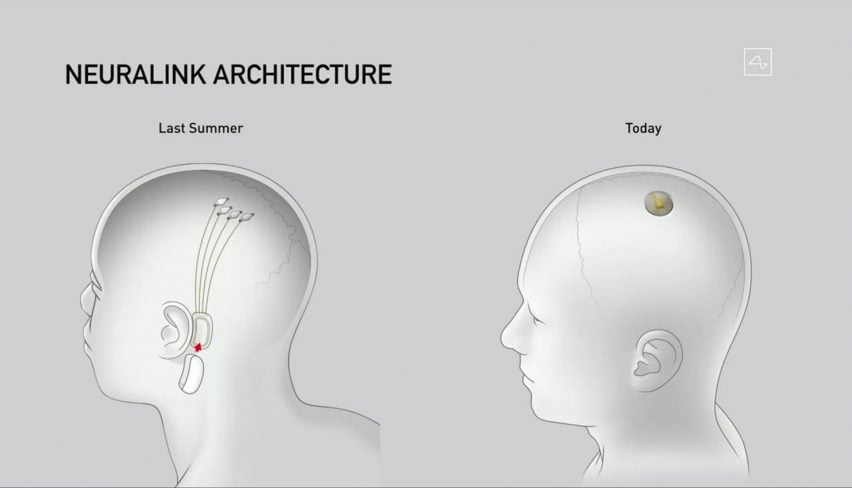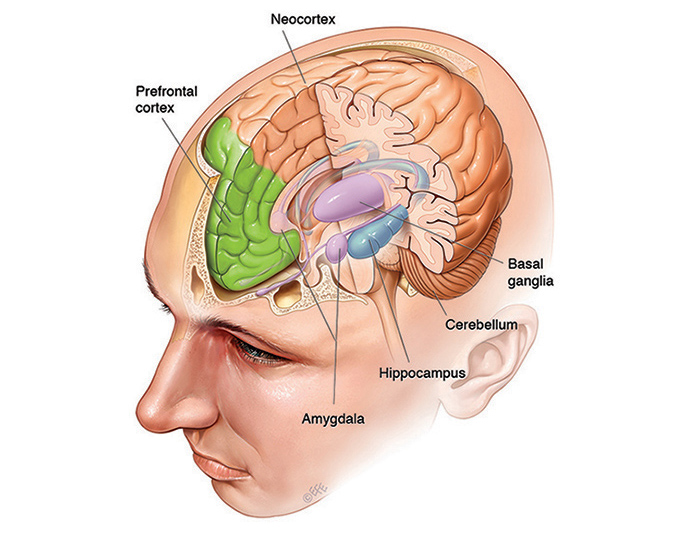Inquiry Question: Should humans and technology be combined?
Research Notes:
- How would a chip in the brain work?

-
- The idea of combining humans and artificial intelligence has been theorized for decades but is only beginning to be manufactured. (Hamilton, 2020)
- In an interview with two neuroscientists in 2019, three key features were outlined from the Neuralink’s design: (Aperture, 2020)
- The first feature is the floppy wires that could move with the brain without causing damage. (BBC, 2020)
- These wires are slightly narrower than a human hair and carry electrodes which would theoretically be capable of detecting brain activity as well as stimulating it. (BBC, 2020)
- The tissues of the brain are soft and in order to have a machine compatible with the human mind, the wires associated must be flexible and be able to move around. (BBC, 2020)
- This technology is still in the process of development and the duration of how long these wires could last is still unclear. (Hamilton, 2020)
- The material used to make these threads is a commonly used polymer in the field and the electrodes themselves are made of gold. (Hamilton, 2020)
- The second notable feature of these brain chips comes from how they may be inserted into an individual’s mind. (BBC, 2020)
- The probes would be inserted into the brain using a device that resembles a sewing machine. This would use a stiff needle to insert the threads into place about 1 millimetre into the cortex, the outer surface of the brain that plays a key role in attention, perception, awareness, thought, memory, language, and consciousness. (BBC, 2020)
- This machine is programmed to adapt to inconsistent factors of the human brain such as breathing and a heartbeat that may move the brain during the procedure. (BBC, 2020)
- This is done by a feature called online motion correction, which functions by taking a video of the brain’s blood vessels under a microscope and then using a robot to adjust the needle to move with those blood vessels. (BBC, 2020)
- The third key feature of this chip would be the level of power this chip contains and its ability to translate brain activity. (BBC, 2020)
- The chip is designed to be able to interpret the brain activity being picked up by the electrodes. (Aperture, 2020)
- It is difficult to use to get electrical signals out of the brain because they are incredibly small and the farther they have to travel down a thin wire, the more they are going to get distorted by the noise that is always present around us. (Aperture, 2020)
- The goal is to amplify and digitize the signal as close to the source as possible as well as record more places with higher precision. (Aperture, 2020)
- In the official presentation given by Elon Musk in 2019, he announced that this chip had been tested with a monkey and that it had been able to “control a computer with its brain.” (Aperture, 2020)
- However, this did not come as a surprise to neuroscientists as the monkey did not display more advanced abilities such as surfing the internet. This technology is supposedly already present in traditional brain-machine interfaces. That said, very little was revealed about the nature and results of the trail with the primates in order to determine just how far of the brain chip scientists have developed. (Hamilton, 2020)
- Which groups of people would most benefit from this technology?
-
- The first application that experts imagine is likely increased control of a robotic arm or someone who may be paralyzed. Neuroscientists have said that it could be used for patients with a locked-in syndrome which would give them “fine control” over robotic limbs. (Hamilton, 2020)

- Even though neural control of robotic limbs is not a new discovery and has been present since 2012, Neuralink’s technology may just bring this innovation to the forefront of medicine and science. (Hamilton, 2020)
- Touch feedback, or otherwise referred to as haptic feedback, would be possible using Neuralink technology. (Hamilton, 2020)
- This would theoretically be possible if Neuralink’s chips recorded which areas of the brain are stimulated when we touch and interact with the world and in turn, the electrodes could use this information to stimulate the brains of people using robotic prostheses to stimulate this sensation. Which would translate to giving robotic limbs the feeling of touch. (Hamilton, 2020)
- Another key feature of this chip is to improve the recollection of memory, which would in turn affect those with dementia or diseases like Alzheimer’s. (Hamilton, 2020)
- So how does memory work?
-
- In its simplest form, memory is known as the continuous process of information retention over time. (The University of Queensland Australia, 2018)
- It is a crucial part of human cognition and allows individuals to frame their understanding of behaviour in the present by recalling past events. (The University of Queensland Australia, 2018)
- There are 3 main processes that characterize how memory works this includes: (Harvard, 2017)
- 1. Encoding: This refers to the process in which information is taken and learned. Information can be visually encoded, acoustically encoded, semantically encoded (what something means) or by using the tactile encoding (how something feels.) (Harvard, 2017)
- 2. Storage: Refers to how, how much, how long and where the encoded information is retained within the memory system. Here, the encoded information is categorized into the two groups of short-term and long-term memory (Harvard, 2017)
- 3. Retrieval: This refers to the process through which individuals access information. Memory stored in the short-term category is retrieved in the order in which it is stored. For example a sequence of numbers. (Harvard, 2017)
- Long-term memory, on the other hand, is retrieved through association. For example, recalling where you parked your car by returning to the entrance where you accessed the shopping mall. (Brem et al, 2013)
- Which areas of the brain are involved in the retention of memory?
- There are three areas of the brain that are involved in implicit memory. This includes: (The University of Queensland Australia, 2018)
- The hippocampus, located in the temporal lobe of the brain. This is where episodic memories are formed and retained. (The University of Queensland Australia, 2018)
- The neocortex, which is the largest part of the cerebral cortex, is involved in higher functions such as sensory perception, spatial reasoning and language and motor commands. The prefrontal cortex which is a part of the neocortex is also involved in complex cognitive functions. (The Human Memory, 2020)

- Over time, selective memories and information that are stored temporarily in the hippocampus can be transferred to the neocortex as general knowledge. (Brem et al, 2013)
- The amygdala, located in the brain’s temporal lobe, associates emotional significance to memories which is important because strong emotions are more difficult to forget. (The University of Queensland Australia, 2018)
- The permanence in these memories displays the interactions between the hippocampus, neocortex and amygdala are essential in determining the “persistence and stability” of a memory. Meaning, how well it is retained over time. (The Human Memory, 2020)
- The two structures involved in implicit memory include the basal ganglia, which processes emotion, reward processing, movement, habit information and learning. (The Editors of Encyclopaedia Britannica, 2020)
- The cerebellum, located at the rear base of the brain is important for fine motor control. (The Editors of Encyclopaedia Britannica, 2020)
- A chip in the brain may improve recollection by copying the encoded memories using the electrodes that would be transmitted through the flexible wires. (Hamilton, 2020)
- As this technology is still very new and on a trial basis, detailed information about how this machine may sustain memory is rather unclear and is still being researched. . (Hamilton, 2020)
References (in correct format):
Aperture, A. (Director). (2020, January 10). Neuralink: Merging Man and Machine [Video file]. Retrieved October 10, 2020, from https://www.youtube.com/watch?v=0jOjh6lwp9w
BBC. (2020, August 29). Neuralink: Elon Musk unveils pig with chip in its brain. Retrieved October 11, 2020, from https://www.bbc.com/news/world-us-canada-53956683
Brem, A., Ran, K., & Pascual-leone, A. (2013, October 07). Learning and memory. Retrieved October 14, 2020, from https://www.sciencedirect.com/science/article/pii/B9780444534972000553?via=ihub
Hamilton, I. (2020, August 26). Elon Musk’s AI brain chip company Neuralink is doing its first live tech demo on Friday. Here’s what we know so far about the wild science behind it. Retrieved October 11, 2020, from https://www.businessinsider.com/we-spoke-to-2-neuroscientists-about-how-exciting-elon-musks-neuralink-really-is-2019-9
How Memory Works. (2017). Retrieved October 14, 2020, from https://bokcenter.harvard.edu/how-memory-works
Memory Storage: Memory Processes In The Human Brain. (2020, September 07). Retrieved October 11, 2020, from https://human-memory.net/memory-storage/
The Editors of Encyclopaedia Britannica. (2020, September 25). Memory. Retrieved October 14, 2020, from https://www.britannica.com/science/memory-psychology
Where are memories stored in the brain? (2018, July 23). Retrieved October 11, 2020, from https://qbi.uq.edu.au/brain-basics/memory/where-are-memories-stored
My focus for my next research round:
In this research round, I looked into the specific chip that combines the intelligence of a human mind with a technological interface. I also looked into a key feature and target aim of this chip; the sustenance of memory. This is a psychological component of merging humans and AI. My second round of research will further investigate how technology has helped the function of the human body. This may include research into electric prosthetics and analysis into the results, benefits, and complications of that. The second round would also include more research into the physical function of technology and AI. This will help me determine how human bodies have utilized technology in the past as well. Further, this will help me have a better understanding of both the physical and psychological factors associated with the combination of technology and humans. Additionally, I plan to investigate the ethics behind the combination of humans and artificial minds or artificial components and what that would mean for the future of technology. I equally hope to discuss predictions and predicaments relating to this topic and further analyze how exactly a creation like this, if made successfully, will change the way of life. This will all help me answer my inquiry question because I would be looking at what levels we have combined technology presently and how we hope to expand that in the future. In turn, it would help me answer if this combination should be done and which groups of people would be most affected by it.
Thanks for reading!

Hello Rasee!
This is an interesting question that I have never really thought about. This is really well researched and I have learnt so much just by reading this one post.
I am looking forward to reading your second round of research!
Dear Raseeka,
Wonderful first round of research. The bullet points also make it very readable and ‘to-the-point.’ In this hypothetical inquiry question, I am curious who you thought would be in control of it being a reality? (government?) Secondly, what would be its focus? (the retention of information? learning languages?)
I am ingrigued!
Best Regards,
Galicia.